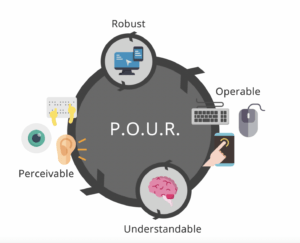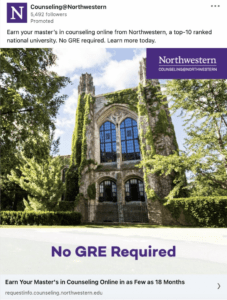When you discuss accessibility and higher education, a myriad of issues, principles and challenges are at play. In the mind of the general public, it’s probably the hot water some of our middle-of-the-road celebrities got into recently trying to get their kids into “elite” schools. Or it could be the real possibility that the U.S. Supreme Court is about to throw out race-based college admissions — a move that would overrule decades of precedents. You could also discuss the more and more colleges implementing and expanding $0 contribution policies.
Even the three A’s covered in the previous installments of this Promoting Your Institution’s Value Propositions blog series — Affordability, Authenticity and Adaptability — all touch on elements of accessibility. Enrollment management is in the business of accessibility. “Admission” is a synonym for “access.”
POUR
For some, when discussing accessibility in higher ed student recruitment, the acronym POUR — Perceivable, Operable, Understandable, and Robust — might come to mind. These are the four guiding principles of website design that help ensure your .edu site and other digital content are accessible to anyone who wishes to investigate your institution … regardless of their abilities.
The principles break down like this.
 P is for Perceivable: Information and interfaces on your website must be presented to a user in a way they can discern regardless of which senses they do or do not have. O is for Operable: Your website interfaces must be able be used by everyone, including people who do not navigate the web using a standard keyboard and mouse. U is for Understandable: The information presented on your website, and the way it functions, must be clear to all users.
P is for Perceivable: Information and interfaces on your website must be presented to a user in a way they can discern regardless of which senses they do or do not have. O is for Operable: Your website interfaces must be able be used by everyone, including people who do not navigate the web using a standard keyboard and mouse. U is for Understandable: The information presented on your website, and the way it functions, must be clear to all users.
And R is for Robust: Your website must be able to support, and be accessed on, a variety of devices including assistive technologies.
POUR has helped thousands of families explore their child’s possible educational future. But let’s take these principles a step further. Sure, your website is accessible, but is your actual messaging — and delivery of those messages — living up to that standard?
Here are a few ideas.
Perceivable Messaging: Are your marketing efforts and messages clear and obvious about what your institution has to offer? Many colleges and universities are not clear about their academic programs, learning outcomes and affordability. Having an open dialog is essential to building trust and brand awareness.
Operable Messaging: Are you providing information that is useful and addresses “fit” when recruiting your future students and marketing your institution? In the current enrollment client, “fit” is probably one of the most important factors of retention. It must be addressed early and often in your communications. This is an expectation of prospective students.
Understandable Messaging: Do you provide messaging that is coherent, logical and relevant? This is a key to any good communication plan. Using behavioral intelligence to understand where the family is in their enrollment journey and to mold and focus your messages creates the necessary relationships.
Robust Messaging: Robust does not necessarily mean large or burdensome when it comes to messaging. Delivering the right message in the right channel can be just as powerful and meaningful as a dozen emails. Keep your messages positive even if you are pushing a deadline. Students and their families want to feel like they are becoming a part of your campus family … not just a transaction.
A Conversation Broke Out
You can’t cover the notion of college accessibility without mentioning the test optional/test blind trend that had been gaining momentum before 2020 and became a full-on pivot for so many institutions during the pandemic.
An example of what test-optional can mean for universities and their students might be best displayed by a conversation that broke out among some Capture Higher Ed colleagues during research for this blog.
One of our senior marketing managers shared this LinkedIn ad promoting Northwestern University’s “No GRE Required” master’s in counseling program with the note: “I don’t know if anyone knows my education background, but I submitted a grad school application to the Department of Psychology at my alma mater in 2014. I was rejected. I had a feeling it was due to my not-so-great GRE scores.”

A co-worker responded: “I never applied to graduate school because I was intimidated by the GRE requirements. When it comes to ‘test intimidation,’ I’m a case study … because (like you) I’m a thoughtful, contentious student that any school should want. I even worked at a university for nine years. During that time, I could have taken classes for free! And I didn’t do it … because I was intimidated by the GRE. Silly.”
Another colleague topped off the back-and-forth with: “I actually just applied to grad school. One of the BIG selling points was that no exams were required for admission. Because for grad/adult learner programs, adding barriers just keeps people away. Several other people in the same info session said the same — that they would not have bothered applying if they had to go through the GRE or GMAT in addition to everything else.”
With all that said, as colleges and universities change their admission requirements, rebound from the recent pandemic, and now face the perceived enrollment cliff, it’s no wonder our messages get lost in the noise that is enrollment marketing. Take time over the next few weeks, during this holiday season, and really dive into who you are messaging, where you are messaging them, and focus your value propositions moving forward. You will be happy you did.
And so concludes Capture’s four-part series on Promoting Your Institution’s Value Propositions. We hope you found some of it interesting and useful. If you missed any of the previous installments, head back and check out Part 1 on Affordability, Part 2 on Authenticity and Part 3 on Adaptability.
By Christopher Harris Ed.D., Senior Enrollment Strategist, and Kevin Hyde, Senior Content Manager, Capture Higher Ed




